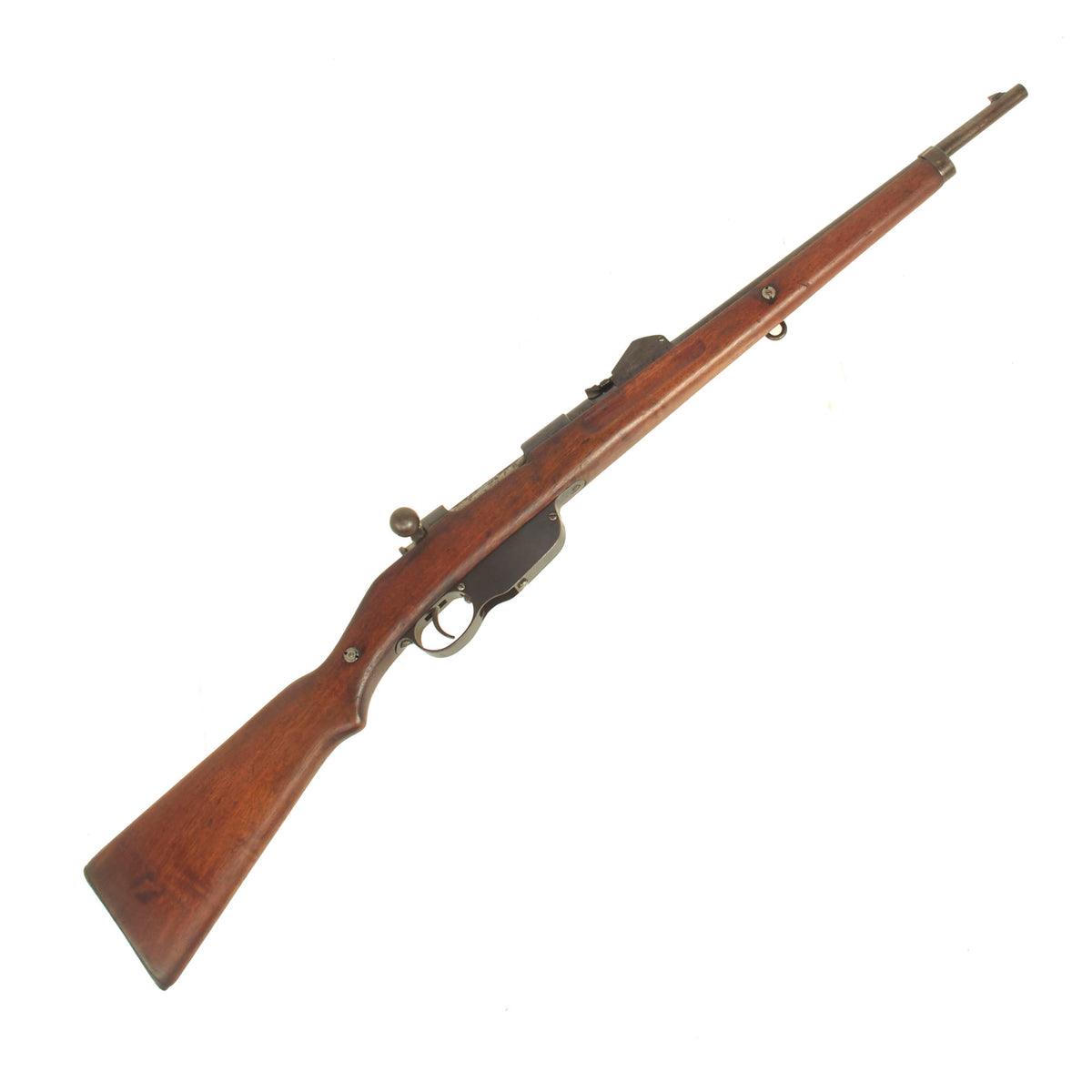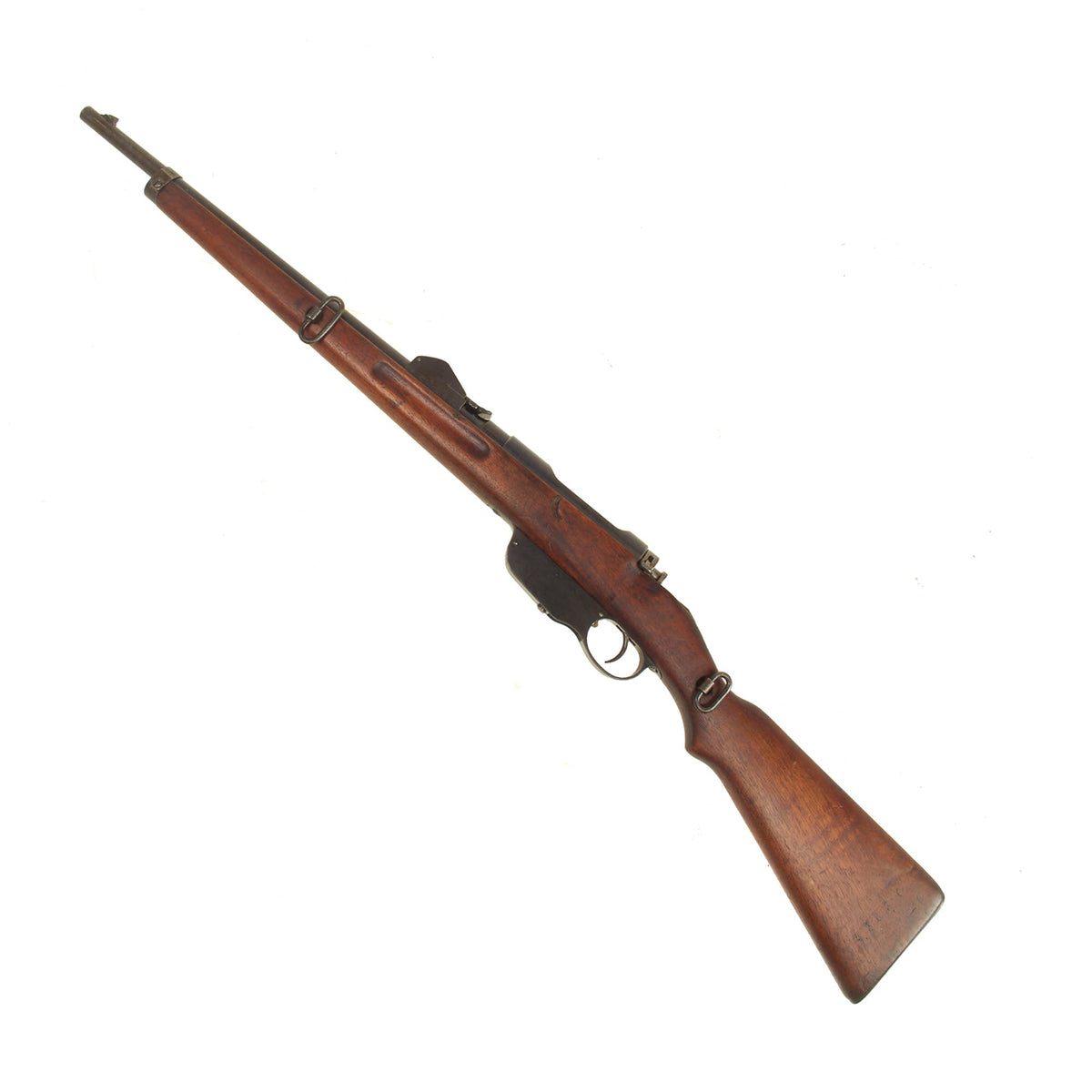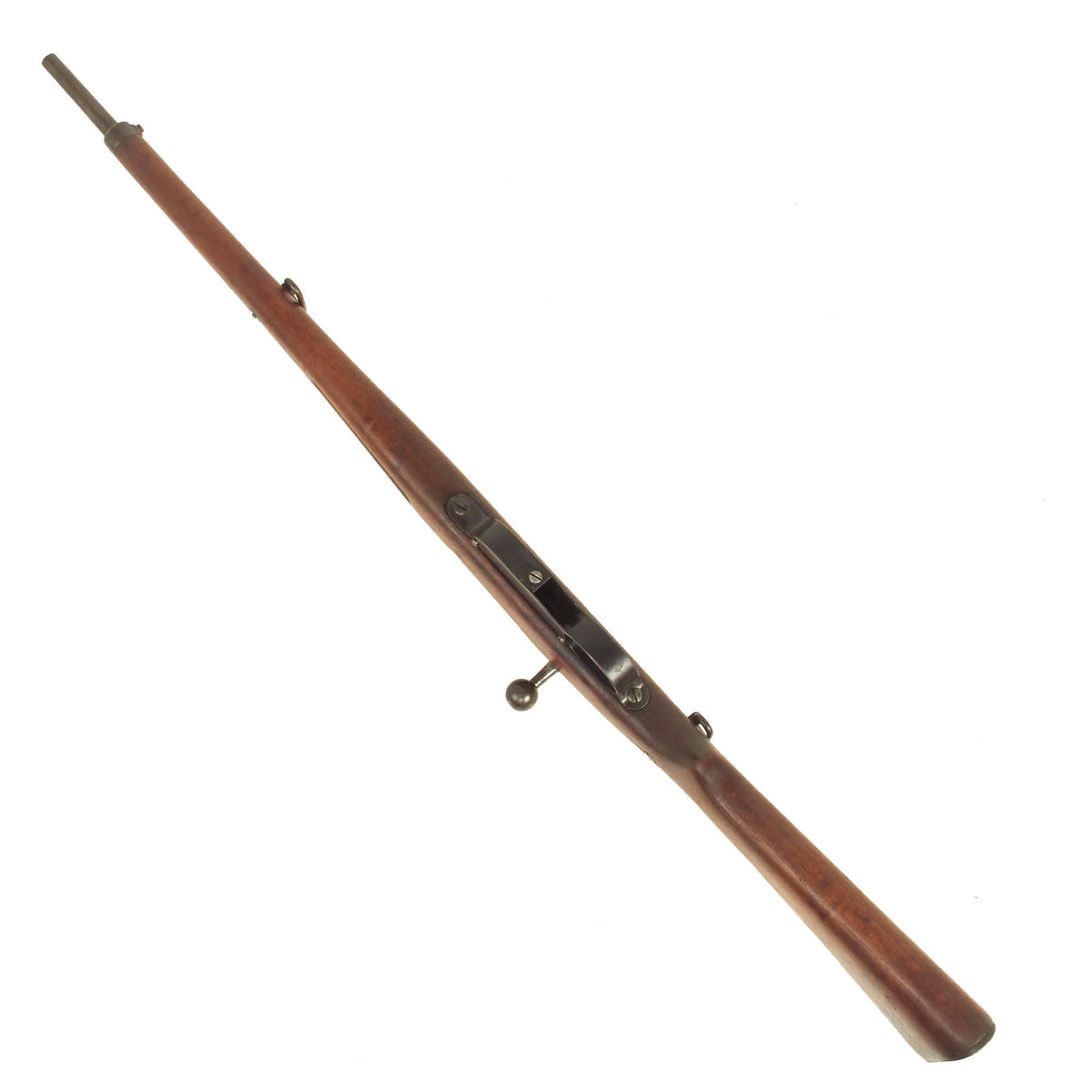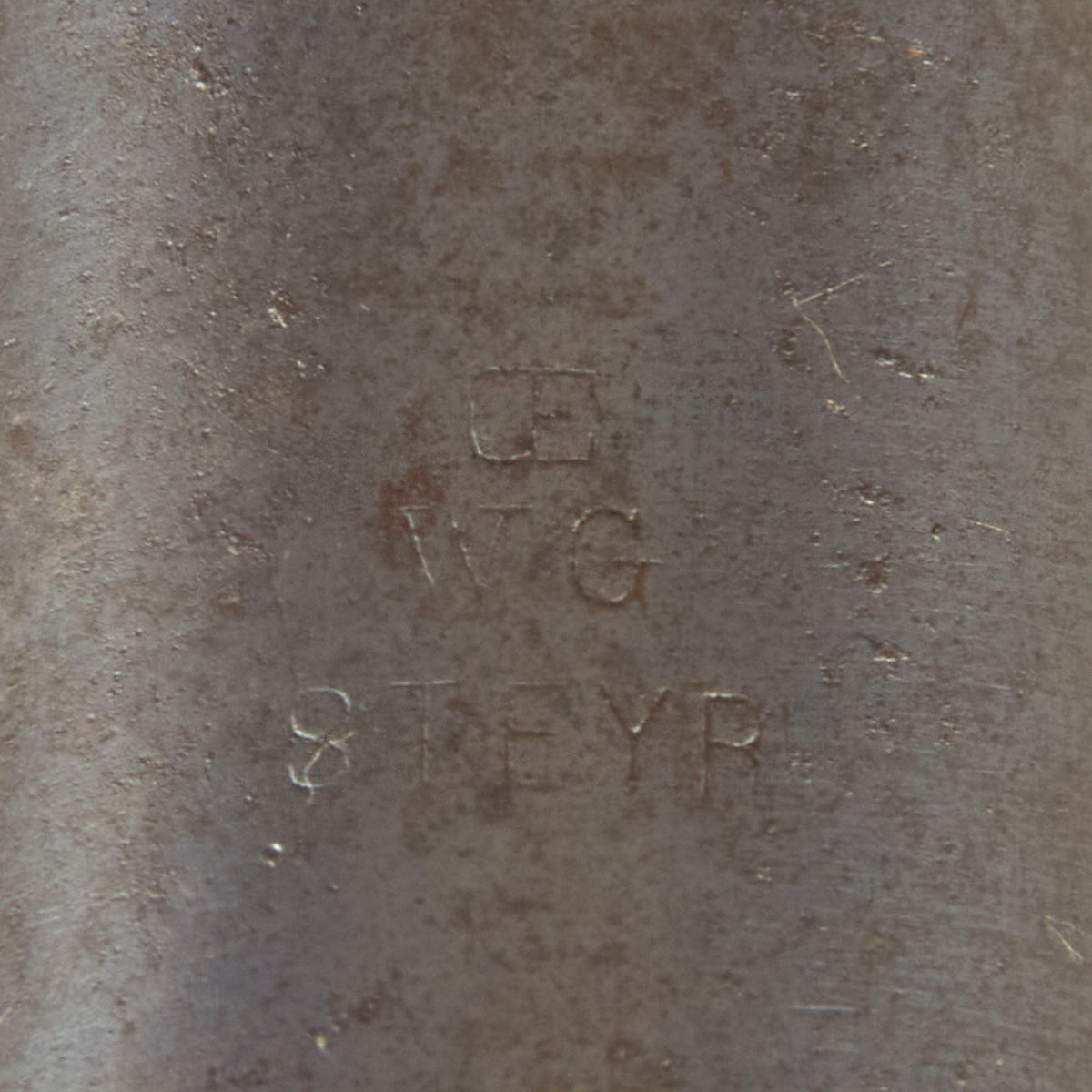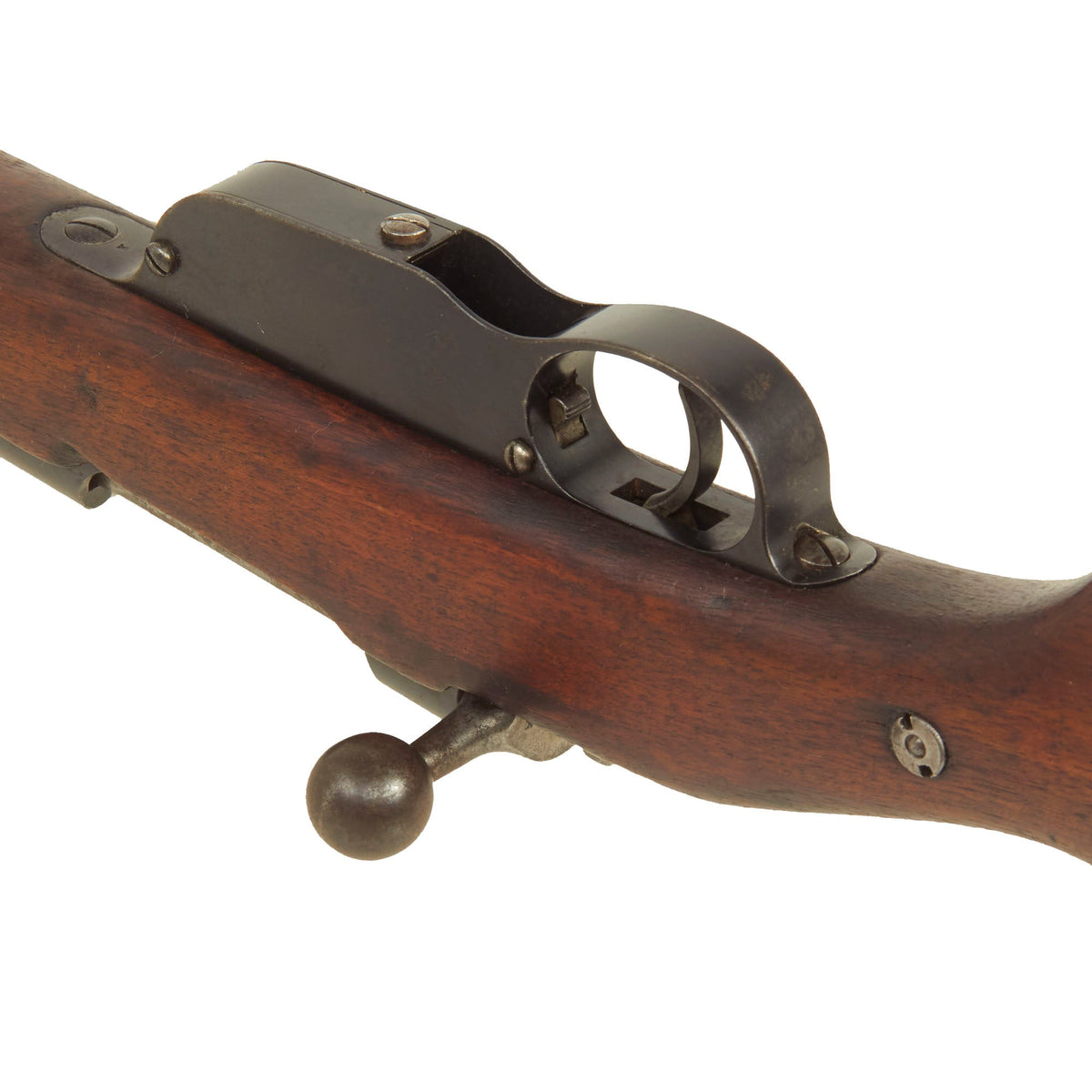Original Austrian Mannlicher M1890 Bolt Action Straight Pull Carbine by Œ.W.G. Steyr dated 1892 – Serial 4363C Original Items
$ 1.295,00 $ 323,75
Original Item: Only One Available. The small arms revolution started by the French M1886 Lebel rifle and its small-bore, smokeless-powder cartridge immediately caused shockwaves throughout Europe’s military establishments. The Austro-Hungarian Empire had just adopted a state-of-the-art technical masterpiece, the M1886 Mannlicher in caliber 11-mm Austrian. The challenge to the Empire was thus relatively simple: develop a comparable modern small-bore cartridge and then adapt their new M1886 to it.
The resulting cartridge was the black powder 8 x 52R Austrian, and the rifle was the Model 1888 Mannlicher (Repeating Rifle Mannlicher 1888), a near-clone of the M1886. Two years later, they developed the smokeless powder 8 x 50R Austrian, the influence of the 8 x 50R Lebel cartridge being obvious, with a new Model 1890 Rifle to go with it. Model 1888 rifles already on hand were then retrofitted, with re-graduated sight ramp attached on the outside of the original sight. The Repeating Carbine Model 1890 a.k.a. Mannlicher Model 1890 Carbine was introduced as an alternative to the Mannlicher M1890 as it was shorter and easier to maneuver with. Three main versions were introduced: Cavalry Carbine, Gendarmerie Carbine and Navy Short Rifle.
This example of an Austrian Mannlicher M1890 Carbine is set up for cavalry, as it has no stacking hook or sling swivels present, and no sign that they were ever installed and then removed. It is marked Œ / W G over the chamber, indicating it was manufactured by Österreichische Waffenfabriksgesellschaft, (ŒWG, Austrian Arms-Manufacturing Company), a legendary factory with a long history. It is also marked with matching serial number 4363C on the left side of the reciever and barrel, and has an Austrian Imperial Eagle proof above the chamber next to a date of 92, for 1892 production.
Condition is very nice, with a great lightly used look. It still has loads of the original blued finish present, with some rust speckling in areas. It doesn’t seem to have been refinished or refurbished at any time, and there is a bit of staining on the bolt, which is still the original bright steel. The bore is in good to very good condition, showing clear lands and grooves but also some fouling from use. The land and grooves are still clear, so it may just need a good cleaning. The rifle cycles correctly, and we did not notice any mechanical issues. The stock is in great shape, with just a few areas of denting and no major damage.
Uncommon and in very good condition. Ready to display!
Specifications-
Years of Manufacture: 1888-1895
Caliber: 8×50mmR
Cartridge Type: Centerfire Cartridge
Barrel Length: 19.6 Inches
Overall Length: 39.6 Inches
Action type: Straight Pull Bolt-Action
Feed System: 5 round En-bloc clip Internal Magazine
More on the Austrian M1886, M1888, and M1888/90 Mannlicher Rifles:
The M1886 was the first Mannlicher design adopted by the Austro-Hungarian Empire. Baron Ferdinand Ritter von Mannlicher was a contemporary of the Mauser brothers, and it can be argued that his designs were more sophisticated and technologically advanced than Mauser models.
The M1886 has a straight-pull bolt, but the mechanism is wholly unlike the later M1895. In this rifle, a tilting breech lock is swiveled into locking position by the forward motion of the bolt handle. The brilliance of this concept is illustrated by its long line of descendants: the Browning Automatic Rifle (BAR); the Bren Light Machine Gun and its Czechoslovakian ZB antecedents; the Belgian gun that became the British GPMG, subsequently adopted by many countries, including the U.S. There were many less-well-known derivatives of this design, also, and the GPMG is still widely used by military forces throughout the world.
Not only was the tilting breech lock revolutionary, but the loading system was also a brand-new development and had a long series of descendents. Mannlicher introduced what is now called the en-bloc or packet loading system. In this system, several cartridges are held together in a sheet-metal clip. The clip and cartridges are all inserted into the rifle’s magazine in one swift motion. When the last cartridge is fired, the empty clip drops out of the bottom of the magazine. Among the major rifles adopting this system one can count the French Mannlicher-Berthier, the Italian Carcano, and, most famously, the United States Rifle M1, or Garand.
Another very interesting feature of the rifle is the dual sighting system. The short-range front sight is a conventional barleycorn (tapered) blade. The rear sight is of an interesting but common 19th-Century design called a quadrant sight. The left ramp is graduated from 00 to 1700 meters and is used in conjunction with the V notch in the top of the sight leaf. The right ramp is graduated from 1800 to 2500 meters for the long-range or volley sight system. This system consists of a tapered-post front sight, mounted on the right side of the middle barrel band, and a very ingenious slide-out V notch on the rear sight leaf.
Fast Shipping with Professional Packaging
Thanks to our longstanding association with UPS FedEx DHL, and other major international carriers, we are able to provide a range of shipping options. Our warehouse staff is expertly trained and will wrap your products according to our exact and precise specifications. Prior to shipping, your goods will be thoroughly examined and securely secured. We ship to thousands clients each day across multiple countries. This shows how we're dedicated to be the largest retailer on the internet. Warehouses and distribution centres can be located throughout Europe as well as the USA.
Note: Orders with more than one item will be assigned a processing date depending on the item.
Before shipping before shipping, we'll conduct a thorough inspection of the items you have ordered. Today, the majority of orders will be delivered within 48 hours. The delivery time will be between 3-7 days.
Returns
The stock is dynamic and we cannot completely manage it because multiple stakeholders are involved, including our factory and warehouse. So the actual stock may alter at any time. It's possible that you may not receive your order once the order has been made.
Our policy is valid for a period of 30 days. If you don't receive the product within 30 days, we are not able to issue a refund or an exchange.
You can only return an item if it is unused and in the same state as the day you received it. You must have the item in its original packaging.
Related products
Uncategorized
Uncategorized
Uncategorized
Uncategorized
Uncategorized
Uncategorized
Armoured Fighting Vehicles of the World: AFVs of World War One (Hardcover Book) New Made Items
Uncategorized
Australian WWII Owen MK1 Machine Carbine SMG Custom Fabricated Replica with Sling Original Items
Uncategorized
Uncategorized
Uncategorized
Uncategorized
Uncategorized
Uncategorized
Uncategorized
Uncategorized
Uncategorized
Uncategorized
Uncategorized
Armored Burgonet Helmet & Polearm from Scottish Castle Leith Hall Circa 1700 Original Items
Uncategorized
Uncategorized
